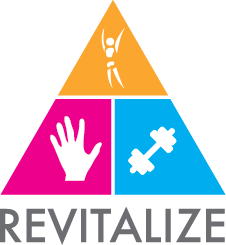At the Revitalize Clinic in Gravesend, we help thousands of people every year recover from pain, regain their confidence, and get back to doing what they love—whether it’s lifting, walking, or simply playing with their grandchildren. But did you know that what you feel emotionally can dramatically influence what you feel physically?
This isn’t just a mindset issue—it’s neuroscience. A powerful study conducted by Stefanucci, Proffitt, and Clore (2008) shows how fear changes perception, and it has huge implications for how we understand chronic pain, movement, and ageing.
📚 The Study: Fear Changes the Way We See the World
In the study, participants stood at the top of a steep hill. Some stood on a skateboard, which made them feel unstable and fearful, while others stood on a solid wooden box—same height, but no threat of rolling down.
They were asked to estimate how steep the hill was using:
- Verbal reports (“how many degrees steep?”),
- Visual matching (aligning a disc to match the slope), and
- Visually guided actions (adjusting a palmboard by touch to represent the slope).
The Results?
- Those standing on the skateboard overestimated the hill’s steepness by a large margin.
- Their fear level correlated with their perception.
- However, their motor response (the palmboard) stayed accurate.
Key takeaway: When we’re scared, we see the world as more dangerous than it is—but we don’t necessarily act that way.
🦵 Implications for Movement and Pain Perception
At Revitalize Clinic, we regularly treat clients suffering from:
- Chronic back pain
- Postural fear and movement avoidance
- Age-related muscle loss (sarcopenia)
And here’s how this study helps us understand them better:
1. 😣 Fear Amplifies Pain Perception
Pain is not just about physical injury—it’s an experience shaped by the brain. When someone is afraid of triggering pain (for example, through bending or walking), they might perceive even gentle movements as harmful.
Just like the fearful participants overestimated the hill’s steepness, pain sufferers often overestimate the danger of movement. This fear can cause them to move less, weakening muscles, and ironically making the problem worse.
2. 🧓 Sarcopenia and Fear of Falling
As people age, they often develop a fear of falling. This can make hills, stairs, or even uneven pavements seem like insurmountable challenges.
The study showed that fear changes visual perception—older adults might genuinely see stairs or slopes as steeper than they are, leading to avoidance. This avoidance leads to reduced muscle use, and eventually, sarcopenia—a condition that makes falling even more likely.
At Revitalize, our Osteopaths and personal trainers in Gravesend work together to gradually rebuild strength and confidence. We show our clients they’re safer and stronger than they think.
3. 🔁 Breaking the Fear-Avoidance Cycle in Chronic Pain
The fear-avoidance model in pain science is simple:
- Pain leads to fear.
- Fear leads to avoidance.
- Avoidance leads to weakness and more pain.
What this study illustrates is the mechanism behind it: fear doesn’t just change behaviour—it changes perception. You’re not “making it up”—your brain really does make hills look steeper (or stairs more treacherous or movements more painful).
At Revitalize, our counsellors and movement therapists work closely with clients to reframe these perceptions. By combining:
- Gradual exposure to feared movements
- Strength and balance training
- Emotional support and education
…we help our clients reclaim their independence.
🧠 Why It’s Not “All in Your Head” – But It Starts There
Some people may dismiss these findings by saying, “Oh, it’s just psychological.” But everything we perceive is processed by the brain. Fear hijacks those processes. You’re not imagining it—you’re experiencing an altered reality based on an emotional state.
That’s why our Gravesend-based team of Osteopaths, personal trainers, and counsellors don’t just treat the body—we treat the whole person. Addressing fear, stress, and perception is as important as exercise and manual therapy.
💬 Case in Point – From Fear to Freedom
Take one of our clients, a 68-year-old woman who developed a fear of walking downhill after a fall. She began to avoid curbs, slopes and even park paths. Over time, this led to muscle loss, balance issues, and worse pain.
Through sessions with our personal trainers and Osteopaths, and gentle encouragement from our counselling team, we rebuilt her strength and her confidence. Today? She walks up and down those same hills as part of her morning routine.
She didn’t just get stronger. She saw the world differently.
🧭 Final Thoughts – Change Your State, Change Your Perception
The study from Stefanucci and colleagues is more than just a quirky psychology experiment. It shows how powerful fear is in shaping what we see and how we move. It’s a vital insight for anyone dealing with pain, balance issues, or age-related decline.
At Revitalize Clinic in Gravesend, we apply these insights daily. Whether you’re working with an Osteopath, personal trainer or counsellor, we aim to restore not just your body—but your perspective.
If you’re feeling stuck, scared, or in pain, you don’t have to wait until you “feel ready.” The truth is, movement will help—but we’ll help you see it that way too.
📞 Call us today on 01474 356 284
📧 Email us at info@revitalizeclinic.co.uk
🌐 Or book in at www.revitalizeclinic.co.uk

